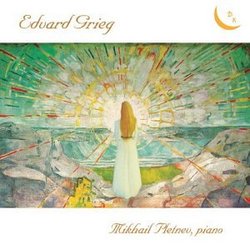| All Artists: Edward Grieg, piano Mikhail Pletnev Title: Piano Pieces Members Wishing: 0 Total Copies: 0 Label: CDK Music Original Release Date: 7/15/2003 Re-Release Date: 8/3/2003 Genre: Classical Style: Number of Discs: 8 SwapaCD Credits: 8 UPC: 634479523328 |
Search - Edward Grieg, piano Mikhail Pletnev :: Piano Pieces
 | Edward Grieg, piano Mikhail Pletnev Piano Pieces Genre: Classical
Edward Grieg (b. 15 June 1843; d. 4 Sept 1907) His time was a golden age of romanticism. National music schools were being founded during the nineteenth century in most countries of Europe. Each school was focused on the ... more » |
Larger Image |
CD Details
Synopsis
Album Description
Edward Grieg (b. 15 June 1843; d. 4 Sept 1907) His time was a golden age of romanticism. National music schools were being founded during the nineteenth century in most countries of Europe. Each school was focused on the promotion of national folklore through research and usage in operas, symphonies, sonatas, and other academic genres. During this time, composers discovered their national heritage. This tendency, visible on the surface of musical life, was a reflection of a more global, profound historical movement - many countries' search for a strong sense of national identity. Grieg established the Norwegian music school. He was not a prolific composer; but almost everything he wrote received international acclaim. He greatly influenced other composers and grew to be a part of world culture. Grieg and his music became a national symbol, a "calling card" of Norway. It is interesting, that being a brilliant master of miniature; he had a lack of ability to develop musical material, like, for example, Beethoven in his larger works? forms. Grieg wrote: "Artists like Bach and Beethoven erected churches and temples on the heights. I only wanted...to build dwellings for men in which they might feel happy and at home." The nature of Grieg?s talent is lyrical; and his melodies are the most expressive and fascinating element. His music speaks and finds its way to everyone. Pyotr Tchaikovsky said of Grieg: "What warmth and passion in his melodic phrases, what teeming vitality in his harmony, what originality and beauty in the turn of his piquant and ingenious modulations and rhythms... add to all this that rarest of qualities, a perfect simplicity." This album embraces piano miniatures written in different periods of his life. The forms are simple, laconic, encompassing a wide range of emotional expression. The music brings the colours and atmosphere of Norway.

 Track Listings (19) - Disc #1
Track Listings (19) - Disc #1